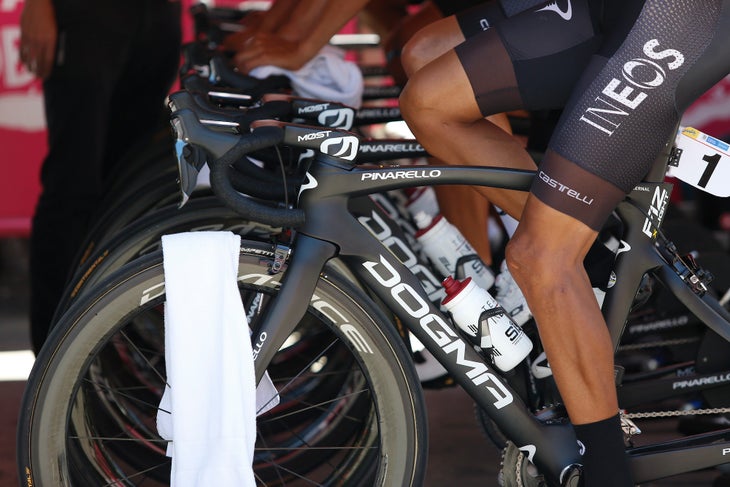Heading out the door? Read this article on the new Outside+ app available now on iOS devices for members! Download the app.
Cycling can be a time-consuming sport and can easily turn from a passion project into a part-time job. Most people are tasked with the challenge of balancing their love for cycling with work, family, and other obligations. A busy schedule leaves limited time to ride bikes and chase improvements, but even with just an hour, it’s possible to make fitness advances. You just have to make the most of every minute.
Have a plan
Make sure you know where you are going and what you’re doing before you get on the bike. Stopping to review a map is a waste of time. Plan your intervals out ahead of time. Without a determined number of repetitions set before you start, chances are that you’ll decide what you’ve done is ‘good enough’ before it actually is.
Interval training
One of the best ways to gain the most fitness from your one-hour workout is to complete intervals. Intervals help to increase your overall training load and therefore, fitness, as well as help to target specific energy systems and muscle fiber types. Your overarching goal will be the primary factor that determines what types of intervals are best for you. Intervals come in all shapes and sizes.
Short duration intervals
Short duration intervals, when executed correctly, can be beneficial for every type of rider.
Short duration and high-intensity intervals with long rest periods in between can help to train fast-twitch muscle fibers and cause neuromuscular adaptations which can be highly beneficial for athletes wishing to increase their sprint capability.
Short, high-intensity intervals, with short rest periods, have been shown to increase VO2 and threshold abilities. In fact, Martin Bonnevie-Svendsen, MD, MSc, BSc analyzed a study in the Scandinavian Journal of Medicine and Science in Sports and found that a protocol of 13 x 30 seconds on with 15 seconds recovery completed 3 times in a workout increased VO2, power output at a set blood lactate level, 40-minute time trial power, and 5 minute time trial power to a greater extent than a protocol of 4 x 5 minute intervals.1
All of this data sounds very confusing, but when broken down the results are simple. Thirteen intervals completed as 30 seconds hard with 15 seconds recovery equals 6.5 minutes of hard work. If that interval set is completed 3 times that is a total of 19.5 minutes of hard work. In comparison, 4 x 5 minutes is nearly the same at 20 minutes of hard work. However, with high-intensity intervals, since you are only completing 30 seconds of work at a time, with 15 seconds of rest, you will likely be able to work harder in the same amount of time. Therefore, it follows that an athlete might be able to achieve a higher level of cardiovascular stress with short duration intervals in comparison to longer duration intervals.

Team Ineos coordinates training sessions. Photo: Maximiliano Blanco/Getty Images
Threshold and sub-threshold intervals
While the evidence demonstrates that short, high-intensity intervals produce great results, longer intervals in the form of tempo, sweet spot, and threshold intensities are here to stay. Longer intervals may range from several minutes to even a single interval lasting the majority of your workout.
Completing longer intervals during a one-hour workout will help to improve your aerobic capacity and your threshold ability. While the aerobic system is generally trained with long rides, incorporating these intervals will give the most bang for your buck in 60 minutes.
Recovery
Recovery is a critical aspect of any training program. Without proper recovery, an athlete risks injury, burn out, and reduced abilities.
Dr. Stephen Seiler introduced polarized training in which an athlete should spend 80 percent of their training going relatively easy, so that the 20% can be really hard. This polarized approach allows the body to rest more so that the hard workouts are met with maximum effort.2 This is one approach that has been proven to be very successful.
There is no one size fits all approach in cycling, and some coaches may claim that the cumulative stress of back to back workouts is beneficial. In the same way that the one-hour workout you select can be indicative of your goals, the recovery you take between them may reflect your goals as well.
Get riding
The most important thing is to get riding. Don’t allow time constraints to be a barrier, instead view them as a challenge that you can overcome!
Sources:
Bonnevie-Svendsen, Martin. “Do Short Intervals Produce Greater Threshold Power?” W/KG, 9 Feb. 2020.
Seiler, Stephen. “What Is Best Practice for Training Intensity and Duration Distribution in Endurance Athletes?” International Journal of Sports Physiology and Performance, vol. 5, no. 3, 2010, pp. 276–291., doi:10.1123/ijspp.5.3.276.